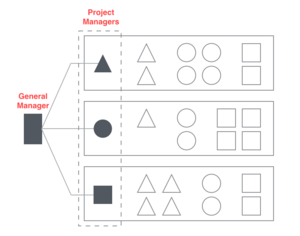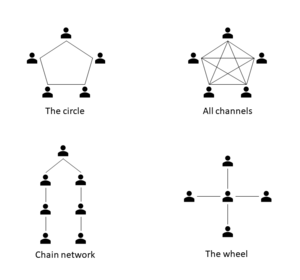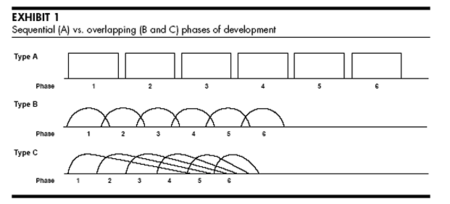Portfolio Management in a Startup
Startups focused on Product Development, which have a relatively wide product/project portfolio, need to deal with scarce resources allocation. This issue is not trivial, as the lack of resources can lead to bottlenecks in the development phases, which are crucial for the survival of the Startup. This article aims to make a selection of the agile methods, tools and organisational structures that best suit early stage Startups, especially those focused on Product Development with a wide product/project portfolio.
Contents |
Background
A Startup can be seen as a business venture conceived to grow rapidly. In Product Development Startups, this potential growth is strongly related to speed-to-market, but what has Project Portfolio Management (PPM) to do with speed-to-market?
Project Portfolio Management is (by definition): the art and science of making decisions to manage a set of projects and/or programs to obtain the maximal efficiency and effectiveness in the use of their available resources, scheduling, deadlines, budget, quality requirements… to best achieve organisation’s operational and financial goals, while struggling with external factors like customer changing requirements, new regulations…. In other words, without a proper Project Portfolio Management, which should orchestrate the resources in the most optimal way, speed-to-market cannot be achieved.
Organisational Structure
Historically, startups' organisational structure has been dominated by a Project Oriented structure, where the CEO can be seen as the Project Manager. As product portfolio grows, CEOs need to delegate the management of the different projects to others, that is, Project Managers. This form of organisational structure is the most suitable for Startups as the resource allocation trade-off is more agile and result-oriented than functional oriented structures. In contrast, its major weakness is that the lack of Functional Management can stagnate the organisation's capabilities in terms of specialisation and gain of expertise throughout the organisation. In return, a rapid and effective cross coordination between the different functional departments is achieved.
In figure 2, an example of the organisational structure for a Startup purely focused on developing (not too complex) electromechanical products is being shown. Six employees and the Team Leader form the core team, the Startup in itself. The Team Leader is the one responsible to allocate the different resources according to the different projects being developed. The grey area refers to outsourced departments and suppliers. Each of the employees is connected to one or several external consultants in order to expand their domain of knowledge for a specific project.
Portfolio Management
The Project Portfolio Management tools and methodologies allow managers to establish a set of processes that best ensure the optimisation of the capabilities and resources of the organisation. It provides a framework for risk mitigation, problem resolution, as well as a centralised point of view to plan and schedule resources, identifying the most suitable for each project/program. Some of the focus areas for PPM are:
Resource Management
Even that Startups' organisation is (by genetics) very flexible and adaptable to changes, a common issue in different types of Startups is certainly the lack of resources: human resources, financial resources, lack of material/equipment and/or knowledge. If not properly managed, it can jeopardise the success of any Startup in an early stage. It is therefore necessary, that CEOs handle this issue from a managerial perspective, in order to enhance effective and efficient organisational processes, which will consequently lead to more effective and efficient business processes. Portfolio Management ensures that the interrelations between all programs and/or projects are identified and the resources are being allocated in accordance of organisation’s strategy.
A good practice to start developing a Project Portfolio Management is to develop a resource matrix to identify all set of resources that the organisation possesses and organise them depending on different attributes (quantity, description, value, capability, competitive advantage, relations…). Thus, potential weaknesses can be identified and solved (or mitigated) by forehand and the decision-making processes for allocating those in the different projects can be done easily based on quantifiable measurements. In addition to project-level resource allocation, manager can also create “what-if” resource scenarios, and extend this view across the portfolio in order to dimension the overall amount and type of resources.
Project/Program Prioritisation
Governance
A well-defined and impeccably implemented governance strategy is crucial for an organisation managing a wide portfolio of projects, programs and products in order to guide the execution of the portfolio into success, that is, the business’ strategy of the company. It is not less important in the case of a Startup. Even that in early stage Startups the non-definition of the processes, the mix of roles, reuse of resources, lack of documentation… may seem a bit blurry from employees point of view, a Startup that does not have a governance strategy it is condemned to failure, But not having a governance strategy can also be a governance strategy: That is the case of self-organising project teams.
Self-organising project teams are a methodology for creating autonomous development teams with high performance. EXPLAIN SELF-ORGANISING PROJECT TEAMS
That is why Startups have so much to win and so little to lose, the dynamics and synergies created among the team is a ecosystem very difficult to replicate in a big corporation, as the organisational rules are usually strict and immovable, but as we have seen in many examples, Startup organisational structures and processes applied to big corporations tend to boost efficiency and effectiveness of the departments where this methodologies are being implemented. (EXPLAIN EXAMPLES: Honda, Canon, Toyota, M3, Apple,..)
Even that the individual capabilities of the group members could be very important, it is critical that the team acts as a whole, sharing knowledge, ideas, points of view… in order to fertilize the field for innovation, but also to grease and adjust the wheels of the development phases into its optimal, that is, synchronise their processes to achieve a trade-off between shortest development time, highest quality and minimal development costs.
SCRUM in Product Development Startups
Effects of not having a Portfolio Management strategy
As stated before, a good Portfolio Management strategy needs to be aligned with the overall business strategy of the company in order to increase percentage of successful projects, programs and portfolios in an organisation, but what happens when this strategy it is not well selected, planned and executed?
Project managers and functional managers fight for the use of resources. This is an obvious outcome for a bad Portfolio Management, especially for Start-ups with low resources. In a scenario with several projects and programs going on, the lack of a higher overview (an entity who works to establish a mechanism to allocate the resources when needed according to the prioritisation of the different projects), can lead to a disastrous management of the available resources, creating disputes between the different managers and stagnating the development of vital projects. Furthermore, this competition for resources among employees leads to a bad working environment, demotivating employees and decreasing overall performance. This constant lack of resources has another influence on the projects, that is, the lack of quality on the final products.
The prioritisation of projects is changing frequently. Since there is not any overall roadmap on which projects are most vital for organisation’s strategy, resources are constantly reassigned, minimising its utilisation and performance and increasing the turnover of the employees and the systems used for developing the different projects. This leads to increasing development costs, which are difficult to justify to stakeholders.
As a confluence of the previous statements, the organisation does not achieve the desired performance, quality, deadline and/or budget; it will (without question) affect the business strategy and therefore, will constrain the economical development of the company.
References
The New New Product Development Game, Takeuchi and Nonaka, 1986 Porftolio Management for New Products, Cooper, Edgett & Kleinschmidt, 2002 Product Design and Development, Ulrich, Karl, 2012 Pioneering the combined use of agile and stage-gate models in new product development- cases from the manufacturing industry, Ahmed-Kristensen, Daalhuizen, 2015 The standard for portfolio management, PMI, 2008



